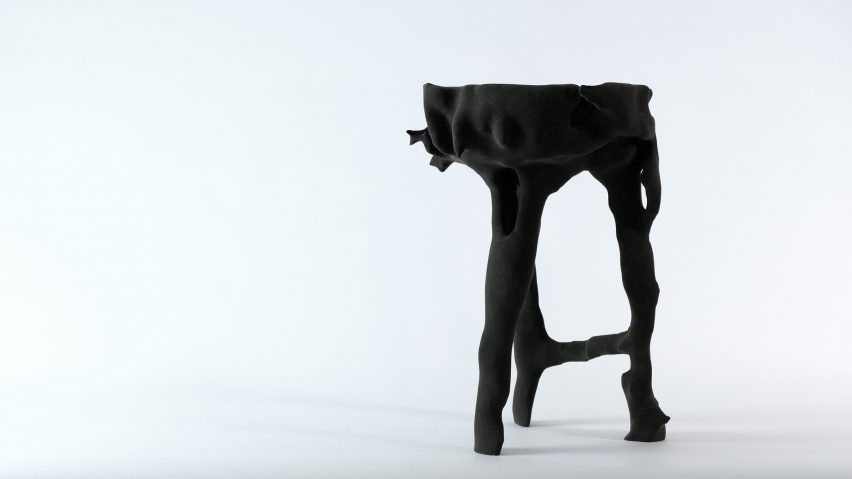Insects are an unlikely "collaborator" in British designer William Eliot's Digested Objects stool, which was shaped by plastic-eating mealworms as they gnawed their way through blocks of polystyrene.
The Digested Objects stool is recognisable as a three-legged seat but has a gnarled and pitted form with no evident logical basis to its contours.
The final piece is 3D-printed in black-coloured sand. But to decide its form, Eliot used waste polystyrene and around 150 mealworms, which are the larvae of the tenebrio molitor beetle.
These mealworms have the ability to digest polystyrene – an otherwise unrecyclable type of plastic – due to the presence of a particular bacteria in their gut.
However, Eliot wanted to do more than use the mealworms as recycling machines. Instead, he wanted to explore the possibilities of biocollaborative design, a variety of interspecies design where the animals or insects are treated as partners in the creative process and allowed to exercise some form of agency.
To ensure the mealworms would produce something roughly in the shape of a stool, he injected the blocks of polystyrene with sugar trails that would draw the insects to eat away those portions of the material first. But then, he left them "free to burrow in any direction they feel".
"The humble mealworm has garnered much attention in the scientific research community thanks to its ability to digest polystyrene safely," said Eliot.
"Instead of extracting and replicating exiguobacterium – the 'superpowered' bacteria that gives the mealworm the capacity to eat plastic – Digested Objects seeks to find a more symbiotic partnership with these creatures."
Eventually, Eliot cast a few of these mealworm designs in wax before 3D scanning and scaling them up digitally to determine which would make the best stool.
He fabricated full-sized prototypes from cardboard, assembling them slice by slice to capture the complex forms, and finally realised the finished Digested Objects stool by 3D printing it in sand.
He collaborated with Sandhelden to use the company's jet-binding technology in this part of the process, as he found that the 3D-printed sand captured the mealworms' tunnels in "a very accurate but natural-feeling way".
"The end result is a magnified view of the architecture created by the mealworm in the polystyrene, captured in the form of a piece of furniture," said Eliot.
The designer said he found inspiration in the work of Neri Oxman, who encouraged silkworms to lay down their silk in sheets rather than cocoons to build pavilions, and in the sculptures of Ren Ri, who worked with bees.
He considered ethical questions throughout the process, such as what would happen to the mealworms at the end of their life and whether their relationship to him benefitted them at all.
He gave them a break from the all-polystyrene diet every few days, providing them with organic biowaste to enjoy instead.
"In contrast to biodesign, which draws inspiration from nature, biocollaborative design centres on the dynamic between designers and the natural world," Eliot told Dezeen.
"Seeing insects and animals as creative partners, not just species that need to be protected, alters perceptions we have of the creatures that inhabit the planet. It opens up creative opportunities, and engages interaction and engagement in ways that go beyond charity."
Eliot developed Digested Objects as part of his graduate degree in Innovation Design Engineering at London's Royal Academy of Art and Imperial College, from where he has now graduated. He has since founded his own practice, Biocrafting Studio.
Interspecies design is emerging as a new way of thinking about sustainability that decentres the needs and experiences of humans.
"We need to think beyond sustainability towards prioritising the natural world," designer Alexandra Daisy Ginsberg told Dezeen in a recent feature on the topic, highlighting projects including an exhibition designed to invite in animals and a garden optimised for the senses of pollinators.

